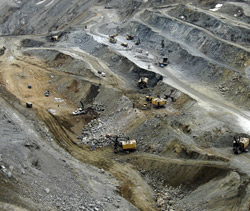In 1998, an Indian company bought 50% of the Ararat gold mines and established the “Ararat Gold Extraction Company”, along with the “ArmGold” state-owned and “First Dynasty Mines Armenia” (FDMA) companies. In 2000, FDMA took control of the Sterlite company, which was registered in the stock exchange market of Toronto, Canada. In 2002, the Indian side paid 3.5 million dollars for 50% of Armenia’s share and the AGEC turned into the mining field of the Indian company for 25 years. Until then, the company had conducted studies in the Soghk mining field belonging to the company and found out that they could extract 50 tons of gold from the certain part of the mining field used. The FDMA is going to do that for the next 12 years. In the meantime, they are also going to try to find other gold resources.
The FDMA started extraction in the Soghk mining field back in 2002. According to the company owners, they have extracted 13 tons of gold so far and have gained a 112 million dollar profit. According to company director Vartan Vartanyan, they have paid taxes worth 2 million dollars each year and other state taxes. The company has invested nearly 50 million dollars for extraction, of which 12 million has been spent for the construction of the Ararat gold extraction factory. The factory administration assures that they haven’t gained profit throughout the past years. They have spent nearly 4 million dollars when the price for gold has sharply gone up during the past couple of years and continues to go up. In order to get a clearer picture, let’s just state one number-there are only 30,000 tons of gold needed to extract worldwide. But it’s quite possible that there are gold mines, which still haven’t been discovered. Gold extraction began in 3000 B.C. and 145,000 tons of gold have been extracted until now. Ninety percent of that has been extracted only after 1958. As a matter of fact, extraction levels have gone up throughout the years. This means that if things go at this rate, gold mines around the world will be consumed within 15-20 years-that is, of course, if new mines aren’t discovered. So, the rise in gold prices in the years to come is inevitable.
The sale of the Soghk mining field was shady and caused a scandal from the start. However, it was similar to all the other transactions that have been made in Armenia so far. Selling 50% of the 50 tons of real gold in Armenia’s mining field to the Indians makes us think that part of the transactions remains under the shade. Some people are of the opinion that during the transaction of the mining field, large amounts of money have gone from the factory to the authorities. The flow continues and is even making its way to NGOs involved in solving ecological issues in order to not cause a scandal. The Indian director of the company, B.K. Sharm, informed us that before becoming a 100 percent shareholder of the company in 2001, president Robert Kocharyan had paid a visit to Vartenis, met with them and ordered to start extraction without any prerequisites. Afterwards, the Armenian share had been transferred to the foreign company. The company administration says that before the Armenian side had transferred the 50% of shareholdings, there were always problems. Work on extraction was postponed due to those problems. Now, they have fewer problems. The only problem left is to move the gold factory from Ararat to Vartenis. The company directors say that there is no factory in the world that is located 268 kilometers away from the mining field. They also say that 10% of the expenses for gold extraction go to transferring-$5.50 is spent for 1 ton. But they didn’t answer the question as to how much one gram of gold costs. It’s rather difficult for them to transfer the mine to Ararat. First of all, the current railway route is old and can’t carry their load; the Armenian railway route doesn’t have enough wagons. Besides that, the Ararat factory’s technical equipment doesn’t meet the requirements for extraction. It is necessary to make technological advances. The company directors said that they are planning on investing 85 million dollars for getting new equipment in the years to come. If you recall, the AGEC had proposed a plan to the Armenian government years ago so that the government would permit them to construct a new factory near the mining field. However, the NGOs involved in solving ecological issues caused a scandal and that project wasn’t implemented. The Indians had to build the factory 6-7 kilometers away from the Sevan Lake. While the gold ore is exploited, it is enriched with cyanogens and the flow was going to cause an ecological disaster near the lake, especially the Sevan Lake. Besides that, the “law about the Sevan Lake” prohibits the construction of a similar factory. One of the directors of the company said that they will no longer propose projects to the government because they know that they will be rejected. The other said that they are going to approve whatever the government approves. They added that the company has proposed another project, which is aimed towards constructing the factory 35 kilometers away from the Sevan Lake. These contradicting announcements get us to thinking that the company is planning something, the government is negotiating and that it will all be revealed soon. Most probably, this week the entire shareholding of the AGEC, or part of it, will be handed over to the Indian “Vedanta Resources” company. Let’s just point out that that company is not “foreign”; AGEC is the sister, or cooperative worker, of “Sterlite”. According to the representatives of AGEC, this hand-over and acceptance will be formal.

